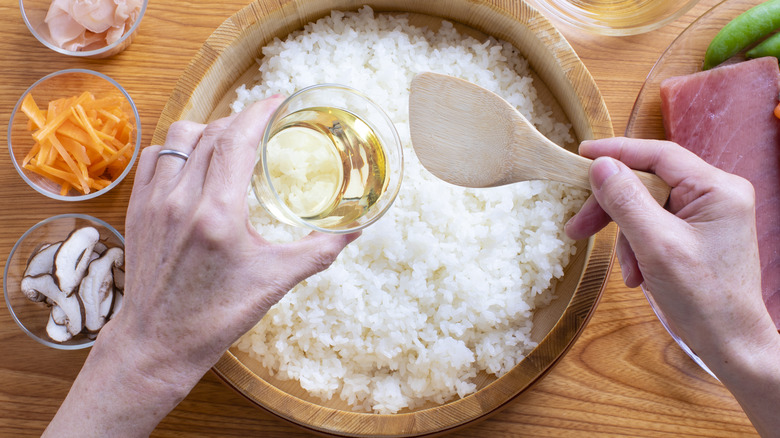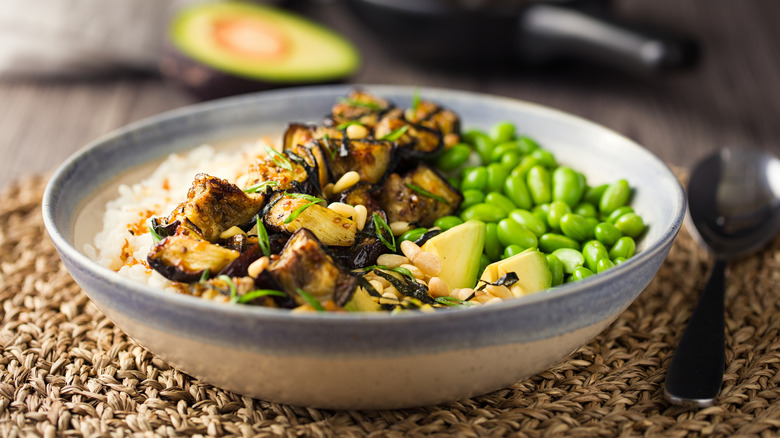Sushi Salad Is The Perfect Way To Shake Up Your Summer Meals
Raw fish, fresh vegetables, and glorious rice. Sushi is a moreish culinary experience that explores a symphony of sweet, tangy, salty, fishy, and umami flavors. It may not be one of the six types of sushi you would recognize at a sushi bar, but sushi salad's another delightful variation to consider. This innovative twist on the classic dish is an exciting and delicious way to revitalize your summer meals.
Making sushi rolls can be time-consuming, and let's be honest, it can take a lot of patience. A sushi salad has all the beautiful flavors of a sushi roll but in a more accessible format. If you're not so keen on chopsticks either, there's no better way to eat sushi salad than with a spoon so you have a solid out. This dish might remind you of a poke bowl, and there are definitely similarities, but its flavor profiles are deeply rooted in Japanese cuisine.
What's fresher than sushi?
In its most basic version, a sushi salad can include a layer of sushi rice, nori sheets, shredded carrots, avocado, and cucumber. All topped off with a dressing and toasted sesame seeds. The salad will resemble a sushi roll that was never rolled. It's delicious, fresh, and light. Perfect for hot summer days or lunches in any season. This salad must be made with sushi rice or shari — "舎利" in Japanese. Sticky rice is more glutinous and will not give you the perfect canvas for your sushi toppings to blend with.
There are two essential components to a sushi salad that may not catch your eye like the vibrant carrot or fresh cucumber, but they are equally important (if not more so) for the taste. The first is in the seasoning for the sushi rice. Ideally, you want to season the rice with at least rice wine vinegar, salt, and sugar. The rest of the salad will suffer if the rice isn't seasoned. The dressing is just as significant and will complement and unite the flavors in the sushi salad. The dressing can be as simple as a sprinkle of soy sauce with or without a touch of wasabi. It's guaranteed to amplify those salty, umami elements to the rest of the salad.
The limits of your sushi imagination
Sushi salads can be constructed like the one described above, but they are also entirely personalizable. Not a fan of seaweed? No problem. If you want to increase the protein, add marinated tofu, honey-glazed aubergine, salmon, imitation crab meat, unagi (eel), or tuna — you name it, you can add it. Sushi is inventive and creative, so replicate this in the ingredients you add. You can also be more adventurous with the dressing; try a miso-sesame combination for a slightly sweeter umami injection.
Adding sake to your sushi rice is another way to shoot more flavor into the salad. Since sake is made from fermented rice and is available in various forms, it can work to accentuate the umami elements. If adding drinking sake is a little bogie for you, you can try akazu or red vinegar instead. It's made from the yeast byproduct of sake. It's a deep reddish color and amplifies your rice with more refreshing umami undertones. It's naturally sweet, so you can omit the sugar from your rice seasoning recipe. Instead of making predictable sushi rolls or monotonous summer salads, why not shake up your summer meals by combining the two? You could be pleasantly surprised.


